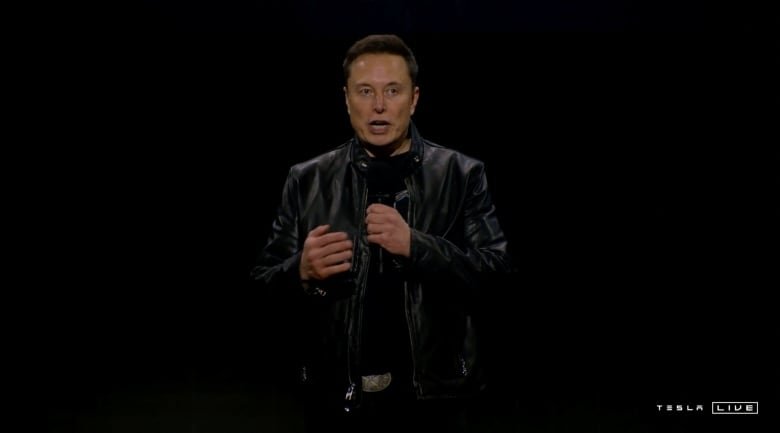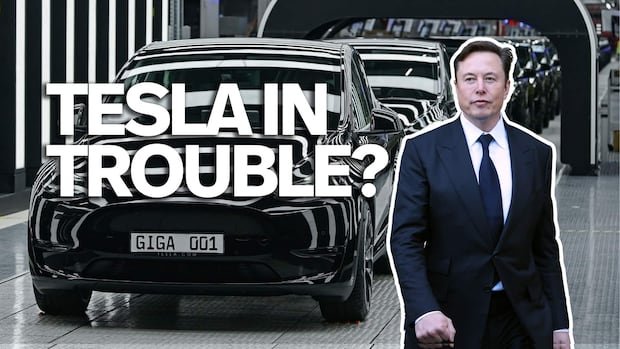Tesla CEO Elon Musk showcased on Thursday a long-awaited robotaxi with two gull-wing doors and no steering wheel or pedals, in a display that has largely failed to create much fanfare.
At a glitzy unveiling, Musk reached the stage in a “Cybercab” to be produced from 2026 — eventually in high volume — and priced under $30,000 US. He then introduced a robovan, which he claims can carry up to 20 people, though he offered few further details.
But Musk, who has a record of missing projections — and himself said he tended to be optimistic with time frames — did not say how quickly Tesla could ramp up production, clear inevitable regulatory hurdles or implement a business plan to leapfrog robotaxi rivals such as Alphabet’s Waymo.
Investors were evidently skeptical after the event — Tesla’s stock fell nearly nine per cent on Friday.

Analysts and industry experts said establishing fully autonomous taxis could take years, particularly given the need to ensure safety and reliability. They pointed to accidents involving the technology, as well as the difficulties it has responding to scenarios such as inclement weather, complex intersections and pedestrian behaviour.
But Musk, wearing a leather jacket and addressing crowds at the Warner Bros. studio near Los Angeles, posited that autonomous cars could be 10 times safer than those driven by humans, and drive five to 10 times longer.
“The autonomous future is here,” Musk said. “With autonomy, you get your time back.”
Krzysztof Czarnecki, professor of electrical and computer engineering at the University of Waterloo, said he wasn’t convinced that Tesla’s technology is there yet.
There is “a big gap” between what was presented Thursday and what would be necessary for robotaxis to operate safely in busy downtown traffic, he said.
“Building a robotaxi without a steering wheel — that any [original equipment manufacturer] can do today,” he said.
“What they presented was some vehicle hardware and some vision. Most of that vision has been articulated before.”

Musk had previously said he planned to operate a fleet of self-driving Tesla taxis that passengers could hail through an app. Individual Tesla owners would also be able to make money on the app by listing their vehicles as robotaxis, he had said. He made no mention of the app at Thursday’s event, despite painting a picture of a future where an owner might send their car away to be used by others while they’re at work.
From automaker to AI robotics company
The event — titled “We, Robot” in an apparent nod to the I, Robot science-fiction short story collection by Isaac Asimov — echoed Musk’s comment that Tesla “should be thought of as an AI robotics company” rather than an automaker.
It started after a delay of nearly an hour, which Musk attributed to a medical emergency involving an attendee. The event ran for less than half an hour and was watched by about four million people on Musk’s X social media platform alone.
“I’m a shareholder and pretty disappointed. I think the market wanted more definitive time lines,” said equity trader Dennis Dick at Triple D Trading. “I don’t think he said much about anything.”
One Tesla owner who watched the event told CBC News that he found it “a little bit underwhelming.”
John Dixon, president and founder of the Tesla Owners Club of Ontario, said that he owns a Tesla because he believes “there’s no doubt” that Tesla’s technology is ahead of its competitors.
“But I didn’t really see anything [at Thursday’s event] that was for the short term, like the next year or two, right?” he said.
Tesla’s stock has fallen more than 33 per cent this year as Elon Musk’s flagship company struggles to meet investor expectations for vehicle sales. Andrew Chang explores how much of this underperformance is related to the broader EV market and how much is related to the company itself.
Experts skeptical
Running the Cybercab will cost 20 cents a mile over time, and charging will be inductive, requiring no plugs, Musk said. Operating the robovans will be even cheaper — at five cents a mile.
Rather than hardware common among robotaxi rivals, such as lidar, Musk said the new vehicles will rely on artificial intelligence and cameras — an approach experts have flagged as challenging both from a technical and regulatory standpoint. Lidar uses laser pulses to create a 3D map of the environment around a vehicle, providing more specific data on potential obstacles or entryways. Alphabet’s Waymo robotaxi uses lidar along with cameras and radar.
Czarnecki, whose research focuses on autonomous vehicle safety, explained that if the robotaxi technology relies exclusively on cameras, it can make errors such as mistaking a shadow for an obstacle and swerving suddenly. He believes the AI technology, while impressive, isn’t there yet, either.
“I would give Tesla a failing grade on safety engineering, because AI, the way it is implemented in [fully self-driving vehicles] and the technology that exists today, will make mistakes,” Czarnecki said.
“This is a vehicle. If it makes a mistake, runs a red light, people get killed.”

Musk said in 2019 he was “very confident” Tesla would have operational robotaxis by 2020. This year, he diverted focus to the Cybercab and scrapped plans to build a smaller, cheaper car widely seen as essential to countering slowing EV demand.
“I think what consumers want … is an affordable EV,” Dixon said. “And I’m a little bit disappointed that Tesla hasn’t gone there yet.”
Beyond vehicles, Musk touted “a lot of progress” with Tesla’s humanoid robot, Optimus, which could eventually perform many daily tasks and be priced at $20,000 to $30,000.
Tesla is at risk of posting its first-ever decline in deliveries this year as buying incentives have failed to attract enough customers to its aging EV lineup, according to Reuters calculations based on third-quarter earnings. Price cuts meant to offset high interest rates have also squeezed profit margins.
Several companies attempting to crack the robotaxi market have suffered billions of dollars in losses, forcing some to shut down.
Alphabet’s Waymo, with about 700 Jaguar Land Rover cars in its fleet, is the only U.S. firm operating uncrewed robotaxis that collect fares.
Self-driving technology
Amazon’s Zoox is testing purpose-built vehicles that resemble toaster ovens on wheels and lack manual controls. Cruise from General Motors, which uses the Chevrolet Bolt EV, this year indefinitely suspended plans to develop its self-driving Origin without controls.
Tesla’s approach to full self-driving (FSD) technology, in its current iteration, requires constant driver attention but keeps costs down. It has, however, faced legal scrutiny, with at least two fatal accidents involving the technology.
“We do expect to start fully autonomous, unsupervised FSD in Texas and California next year,” Musk said. “That’s with the Model 3 and Model Y.”
He did not say whether the Cybercab uses FSD or new technology.




